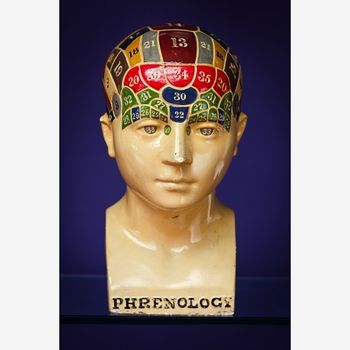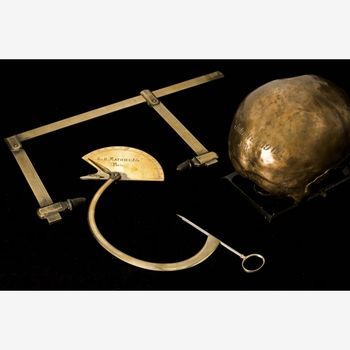Phrenology

Glazed bust of phrenology head showing the key skull areas that were believed to reflect the underlying brain functions. From the shape of the head it was believed that someone's personality characteristics could be identified.
Phrenology is the formal practice of assigning personality traits to individual people on the basis of the contour of their skulls and facial features.
"Attempts to classify people into different personality types is as old as the history of medicine...Phrenology attempted to obtain this information from feeling the shape and particularly the peaks and valleys of the skull. It was popular during the Victorian era, and like physiognomy, was believed to be useful in detecting criminal behavior."[1]
The founder of phrenology was Franz Joseph Gall (1785–1828), a physician from Vienna and a very capable neuroanatomist.[2] He had a theoretical view that, in and of itself, was plausible: if the human brain had areas within it that were responsible for specific mental functions, then the relative power of these functions correlated with the size and development of the regions, and the outer contour of skull, in terms of excesses and deficiencies in shape, was physical evidence of the size of those brain regions.
In the early 19th century, some of the advocates of phrenology were not so much interested in personality but in the biological function of the brain. Some, like Gall, thought that each region of the brain had a separate and distinct function. His views were furthered by "his disciple Johann Gaspar Spurzheim (1776–1832)."[3] Those who shared this view included the great early neuroscientists Pierre Paul Broca and David Ferrier, who went on to demonstrate the actual areas of the brain responsible for such functions as speech. Others, like Friedrich Goltz, insisted that the entire cerebrum acted as a whole, and that the idea of investigating localized areas as the basis for specific qualities of the brain function had no merit. By 1860, phrenology was largely discredited within the academic ranks of biologists, but became increasingly popular as a clinical "science".
The acceptance of phrenology was helped by the presence of physical characteristics that were common to families and ethnic groups and could be correlated to generally held notions about those groups. So, for example, the larger skull size of larger people could be translated into a higher intelligence for tall Nordic and Teutonic peoples as opposed to shorter Southern Europeans, and of the average man as opposed to the average woman.
By the late 19th century, physicians (and others) practising phrenology were doing a flourishing trade. Many, if not most, cloaked themselves with elaborate trappings of "science", including models of the head and brain, and spoke with an assumption of authority. However, unlike actual scientists, few phrenologists were willing to test their conclusions. The following quote from one of Mark Twain's letters nicely portrays the lack of a noted phrenologist's boldness in making a detailed diagnosis:
"I found Fowler on duty in the midst of the impressive symbols of his trade. On brackets, on tables, on shelves, all about the room, stood marble-white busts, hairless, every inch of the skull occupied by a shallow bump, and every bump labeled with its imposing name, in black letters...Fowler received me with indifference, fingered my head in an uninterested way, and named and estimated my qualities in a bored and monotonous voice. He said I possessed amazing courage, an abnormal spirit of daring, a pluck, a stern will, and a fearlessness that were without limit...but then he foraged over on the other side of my skull and found a hump there which he called “caution.” ... He continued his discoveries, with the result that I came out safe and sound, at the end, with a hundred great and shining qualities; but which lost their value and amounted to nothing because each of the hundred was coupled up with an opposing defect which took the effectiveness all out of it. However, in one place he found a cavity; a cavity where the bump would have been in anybody else’s skull...That cavity, he said, was all alone, all by itself, ...(and) represented the total absence of the sense of humor!"
Several months later, Samuel Clemens returned to Fowler, and this time came as the author, Mark Twain, who was world famous as a great humorist!
"Once more he made a striking discovery—the cavity was gone, and in its place was a Mount Everest—figuratively speaking—31,000 feet high, the loftiest bump of humor he had ever encountered in his life-long experience! I went from his presence prejudiced against phrenology, but it may be, as I have said to the English gentleman, that I ought to have conferred the prejudice upon Fowler and not upon the art which he was exploiting [Feb. 10, 1907; the English gentleman was not really a gentleman: he sold my private letter to a newspaper]."[4]
This anecdote about Mark Twain could likely be repeated with many individual practitioners of the health sciences who might change their interpretation depending on the fame and wealth of their patient. In fact, evidence-based medicine, and all health sciences that attempt to have a basis in the scientific method, strive to find experimental ways to evaluate methods of treatment and diagnosis that avoid bias. Many of the practitioners of phrenology also tried to find hard evidence for their interpretations, but suffered from doing so in the early days of clinical trials and epidemiology, before the ideas of control groups and blinded observers were established. For example, Cesare Lombroso's book The Criminal Man was based on actual examinations of male inmates in Italian prisons. He argued that a slanting forehead, flat nose, and large jaw were all features that indicated a criminal mind.
The Edinburgh Phrenological Society
In 1815, the Edinburgh Review published an attack on phrenology by the anatomist John Gordon, calling it a "mixture of gross errors and extravagant absurdities".[5] In response, Spurzheim came to Edinburgh to take part in public debates and to perform brain dissections. George Combe, a lawyer who had previously been sceptical, became persuaded of the truth of phrenology after seeing Spurzheim perform a dissection. [6] In 1820, at the suggestion of the Evangelical minister David Welsh,[7] George Combe and his brother Andrew, a physician, founded The Edinburgh Phrenological Society. It was the first of more than forty phrenological societies to be founded in the UK.
Footnotes
- ↑ Humours, Physiognomy & Phrenology Health & Stress, 1089148X, 2001, Issue 8.
- ↑ Stone JL (2003) Mark Twain on phrenology. Neurosurgery 53:1414-6; discussion 1416-7, UI: 14633308.
- ↑ Simpson D (2005). Phrenology and the neurosciences: Contributions of F. J. Gall and J. G. Sporzheim. Journal of Surgery 75:475-82.
- ↑ Paraphrased from : Neider C: The Autobiography of Mark Twain. New York, Harper & Brothers, 1959, pp 63–67.
- ↑ p.268, John Gordon, Edinburgh Review 25, 1815, cited in: Thomas F. Gieryn (1999) Cultural Boundaries of Science: Credibility on the Line, University of Chicago Press, p.115.
- ↑ Matthew H. Kaufman (2005) Edinburgh Phrenological Society: A History, William Ramsay Henderson Trust, Edinburgh.
- ↑ John Van Whye, Phrenology and the Origins of Victorian Scientific Naturalism, Ashgate Publishing Limited, 2004.

